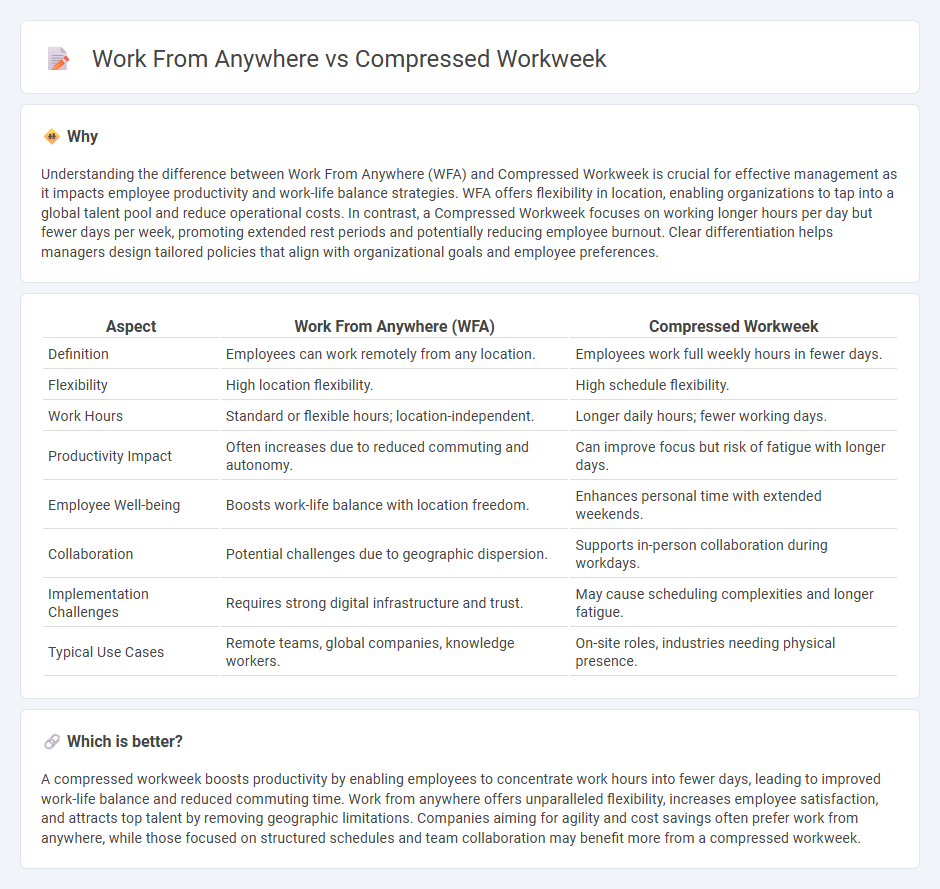
Management strategies such as work from anywhere and compressed workweek offer flexible scheduling to enhance employee productivity and work-life balance. Work from anywhere allows remote access to tasks across diverse locations, while compressed workweek condenses hours into fewer days to maximize efficiency. Explore these innovative models to optimize workforce management and employee satisfaction.
Why it is important
Understanding the difference between Work From Anywhere (WFA) and Compressed Workweek is crucial for effective management as it impacts employee productivity and work-life balance strategies. WFA offers flexibility in location, enabling organizations to tap into a global talent pool and reduce operational costs. In contrast, a Compressed Workweek focuses on working longer hours per day but fewer days per week, promoting extended rest periods and potentially reducing employee burnout. Clear differentiation helps managers design tailored policies that align with organizational goals and employee preferences.
Comparison Table
| Aspect | Work From Anywhere (WFA) | Compressed Workweek |
|---|---|---|
| Definition | Employees can work remotely from any location. | Employees work full weekly hours in fewer days. |
| Flexibility | High location flexibility. | High schedule flexibility. |
| Work Hours | Standard or flexible hours; location-independent. | Longer daily hours; fewer working days. |
| Productivity Impact | Often increases due to reduced commuting and autonomy. | Can improve focus but risk of fatigue with longer days. |
| Employee Well-being | Boosts work-life balance with location freedom. | Enhances personal time with extended weekends. |
| Collaboration | Potential challenges due to geographic dispersion. | Supports in-person collaboration during workdays. |
| Implementation Challenges | Requires strong digital infrastructure and trust. | May cause scheduling complexities and longer fatigue. |
| Typical Use Cases | Remote teams, global companies, knowledge workers. | On-site roles, industries needing physical presence. |
Which is better?
A compressed workweek boosts productivity by enabling employees to concentrate work hours into fewer days, leading to improved work-life balance and reduced commuting time. Work from anywhere offers unparalleled flexibility, increases employee satisfaction, and attracts top talent by removing geographic limitations. Companies aiming for agility and cost savings often prefer work from anywhere, while those focused on structured schedules and team collaboration may benefit more from a compressed workweek.
Connection
Work from anywhere and compressed workweek both enhance workforce flexibility by allowing employees to choose where and when they work, which can increase productivity and job satisfaction. Companies adopting these models leverage technology and trust-based management to focus on output rather than hours, thereby reducing burnout and improving work-life balance. Integrating these approaches challenges traditional management structures, prompting shifts toward results-oriented performance metrics and adaptive communication strategies.
Key Terms
Flexibility
A compressed workweek offers employees extended weekends by condensing work hours into fewer days, enhancing schedule flexibility and work-life balance. Work from anywhere policies provide unmatched location flexibility, allowing staff to perform tasks remotely from any geographic location, boosting autonomy and productivity. Explore the advantages of flexible work models to determine the best fit for maximizing employee satisfaction and organizational efficiency.
Productivity
A compressed workweek boosts productivity by allowing employees to concentrate work into fewer days, resulting in longer, focused periods and reduced absenteeism. Work from anywhere enhances output by offering flexibility, minimizing commute time, and enabling a personalized work environment that supports individual work rhythms. Explore detailed insights to understand which model maximizes productivity for your organization.
Employee Autonomy
A compressed workweek allows employees to complete their work hours in fewer days, enhancing time management and personal freedom, while work from anywhere offers location flexibility, empowering workers to choose their ideal work environment. Both models significantly boost employee autonomy by promoting self-directed schedules and reducing traditional office constraints. Explore more to understand which framework best supports your workforce's autonomy and productivity needs.
Source and External Links
Compressed Workweek: Advantages and Disadvantages | Indeed.com - A compressed workweek allows employees to work full-time hours in fewer than five days, such as four 10-hour days instead of five 8-hour days, offering various schedule options depending on industry and employer.
Pros and Cons of a Compressed Work Schedule - The common 4/10 compressed schedule features four 10-hour days with three days off, improving productivity and work-life balance, while other formats include a 9/80 schedule over a two-week cycle.
What is Compressed Workweek? Schedule, Pros and Cons - Dovetail - Compression involves completing 40 hours in fewer days like a 9/80 schedule with alternating four- and five-day workweeks, requiring careful timekeeping to avoid overtime.
 dowidth.com
dowidth.com